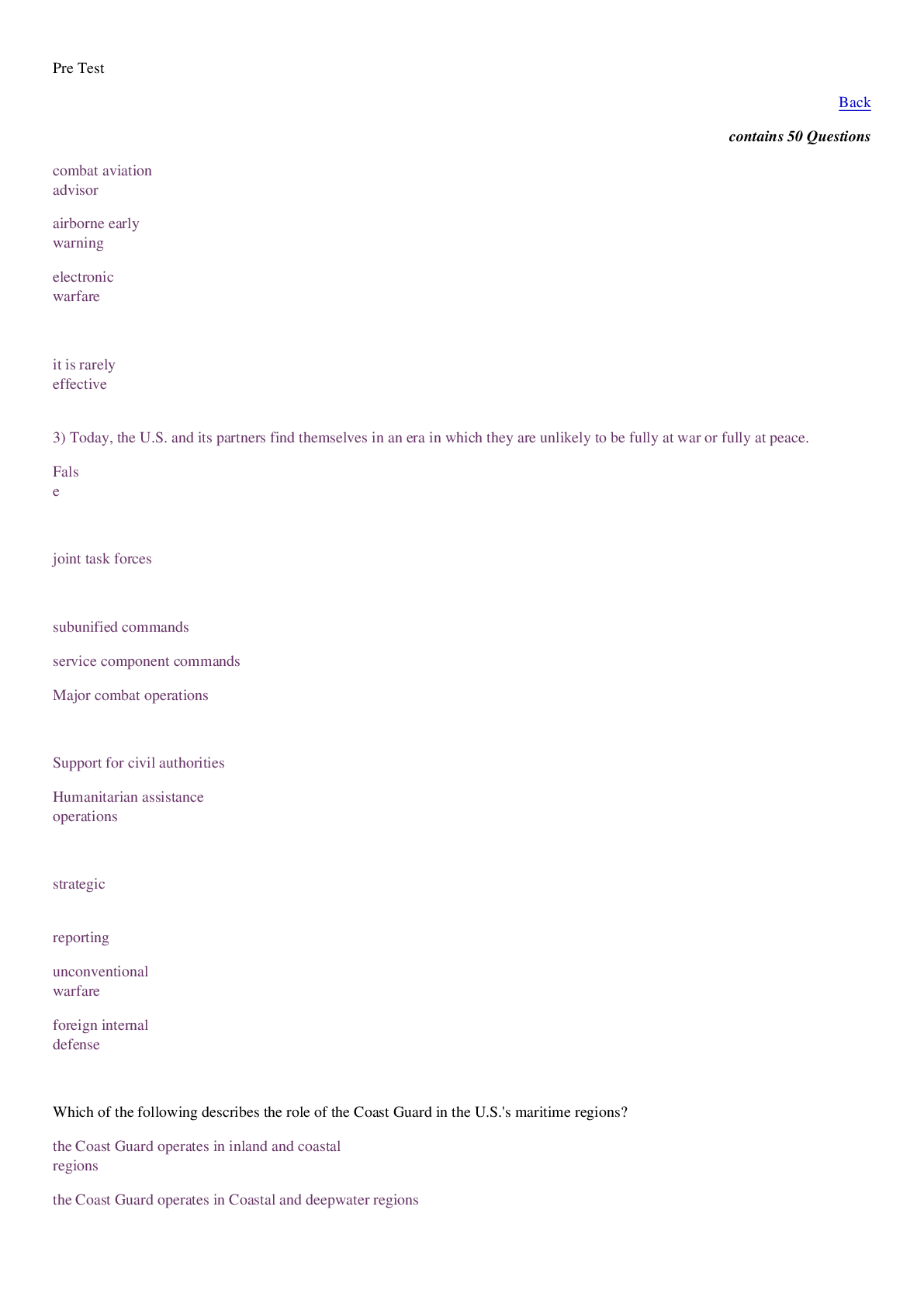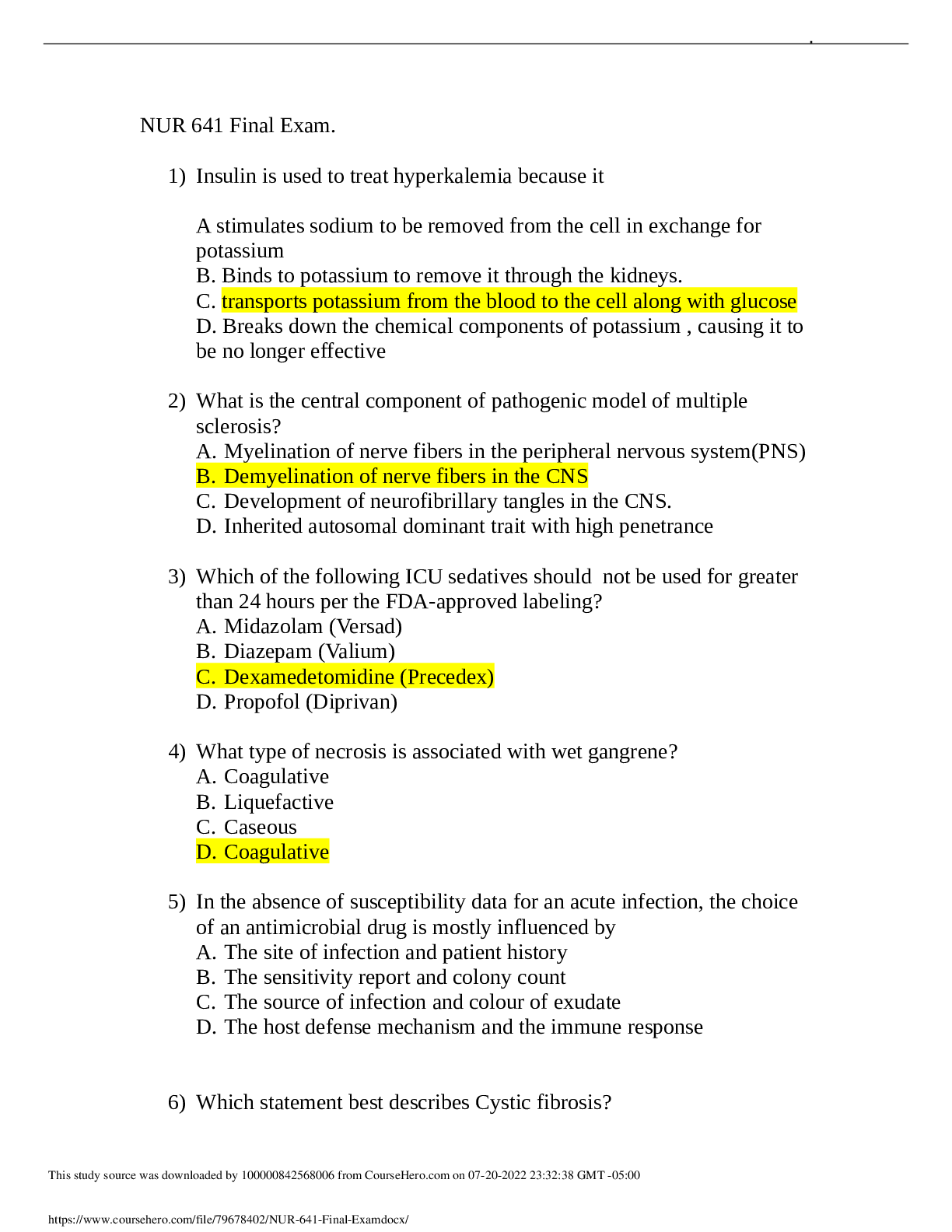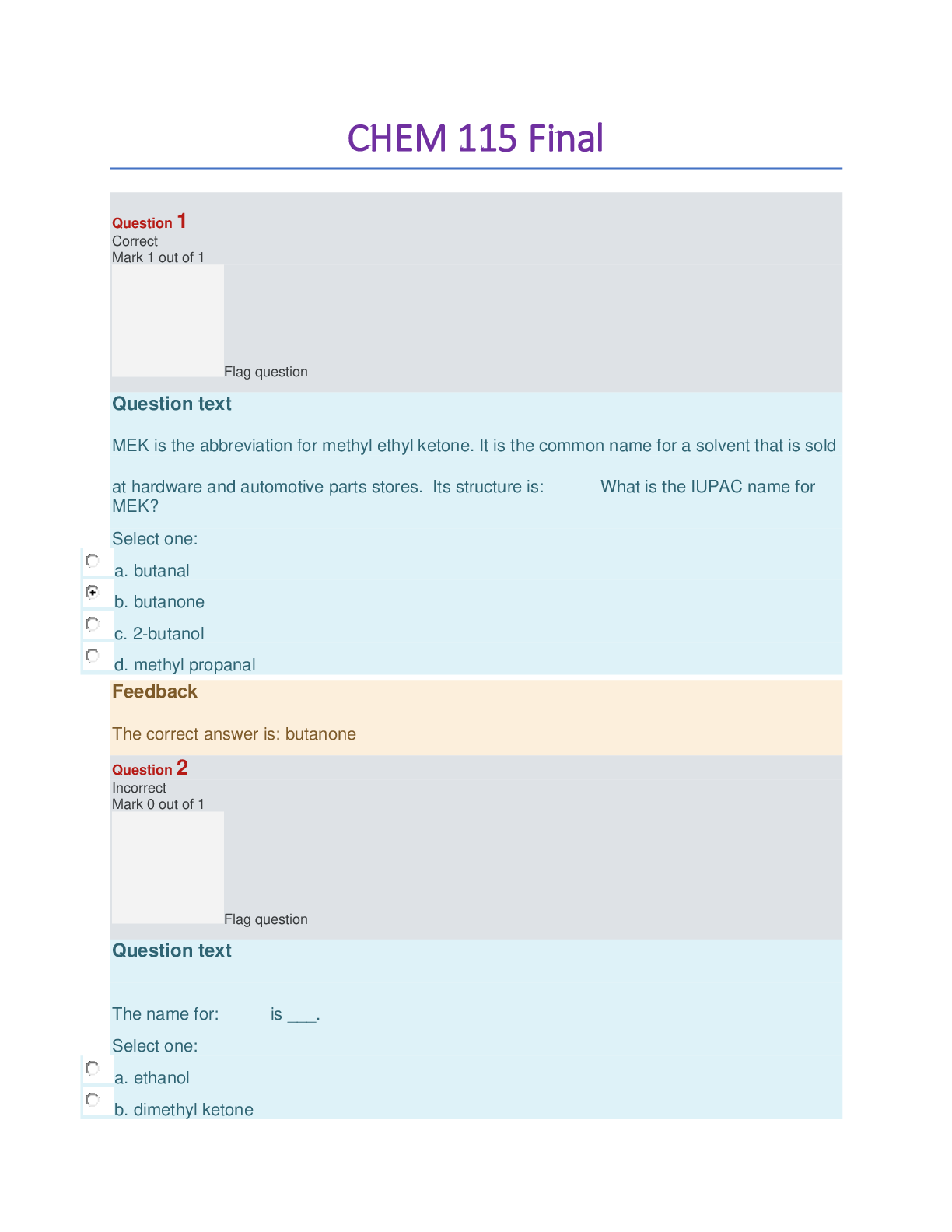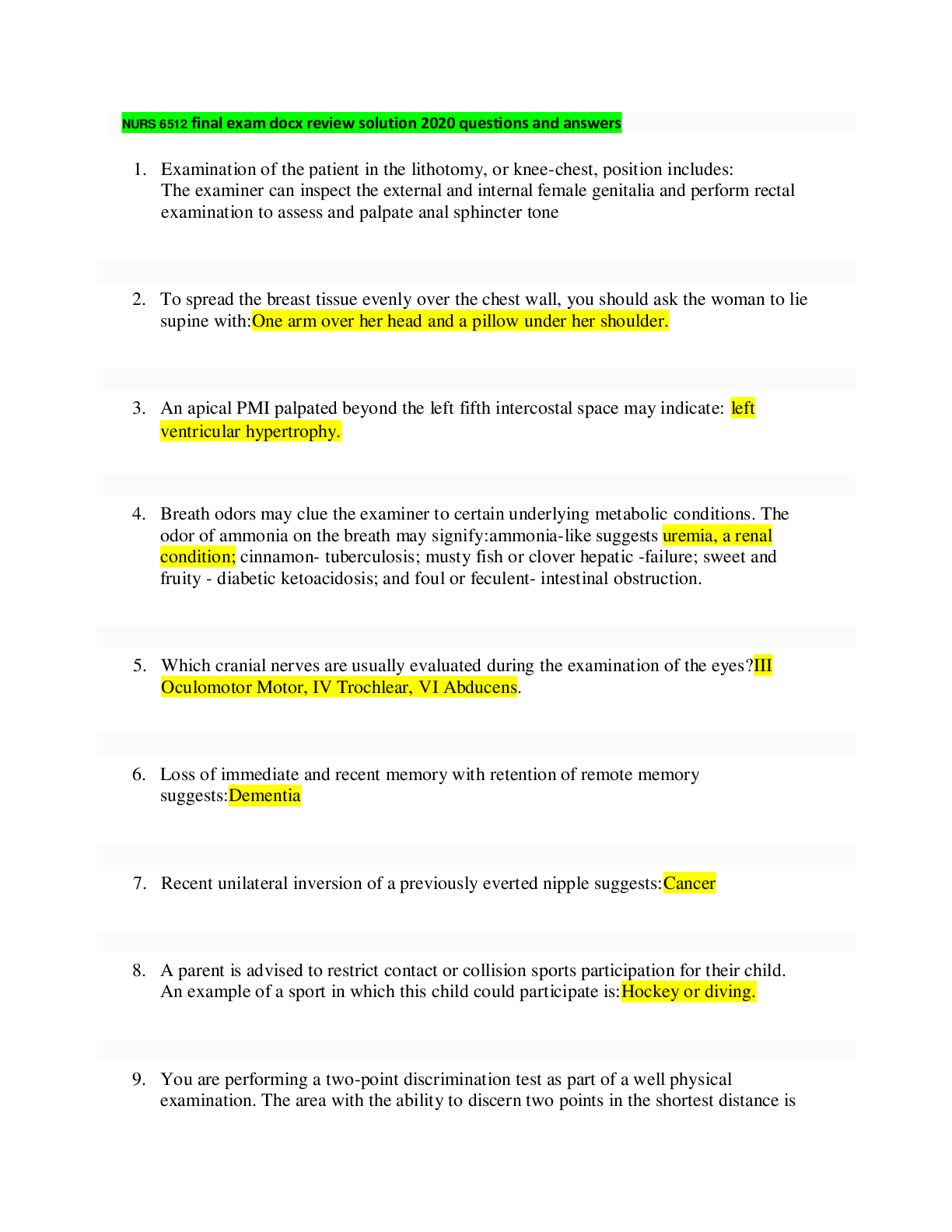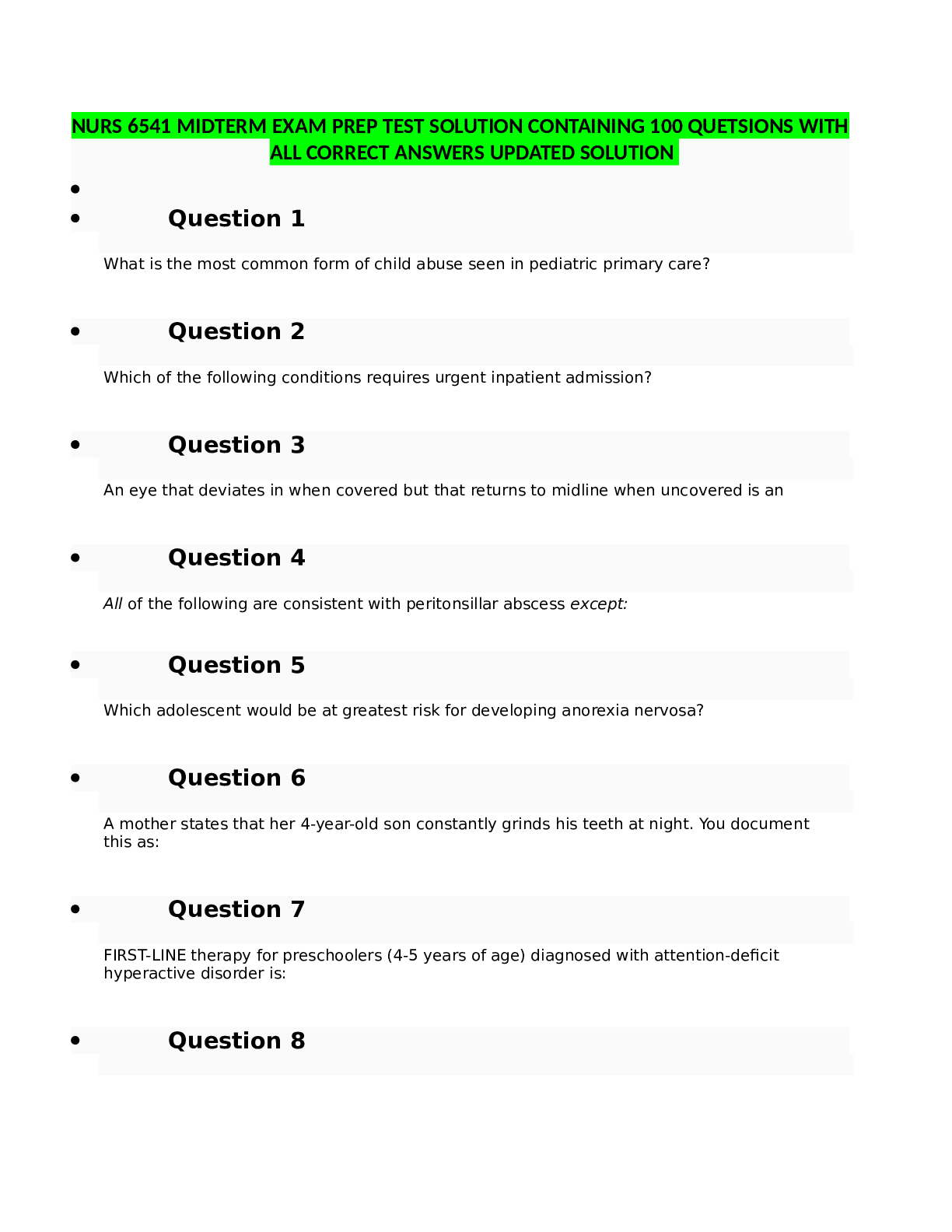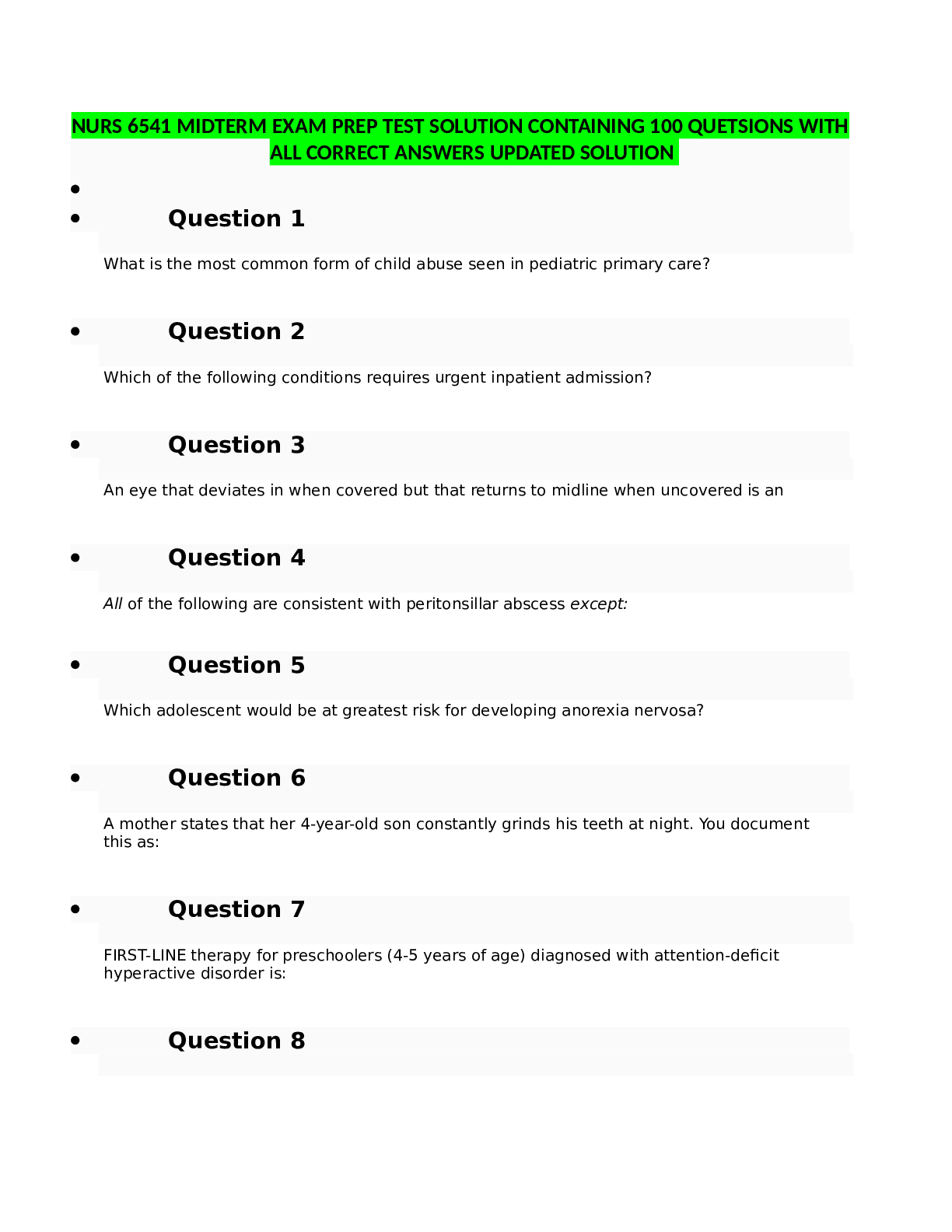*NURSING > EXAM REVIEW > NURS 6541 MIDTERM EXAM PREP TEST SOLUTION CONTAINING 100 QUETSIONS WITH ALL CORRECT ANSWERS UPDATED (All)
NURS 6541 MIDTERM EXAM PREP TEST SOLUTION CONTAINING 100 QUETSIONS WITH ALL CORRECT ANSWERS UPDATED SOLUTION Walden University
Document Content and Description Below
NURS 6541 MIDTERM EXAM PREP TEST SOLUTION CONTAINING 100 QUETSIONS WITH ALL CORRECT ANSWERS UPDATED SOLUTION Walden University • • Question 1 What is the most common form of child abuse ... seen in pediatric primary care? • Question 2 Which of the following conditions requires urgent inpatient admission? • Question 3 An eye that deviates in when covered but that returns to midline when uncovered is an • Question 4 All of the following are consistent with peritonsillar abscess except: • Question 5 Which adolescent would be at greatest risk for developing anorexia nervosa? • Question 6 A mother states that her 4-year-old son constantly grinds his teeth at night. You document this as: • Question 7 FIRST-LINE therapy for preschoolers (4-5 years of age) diagnosed with attention-deficit hyperactive disorder is: • Question 8 A 7-year-old has just been diagnosed with attention deficit hyperactivity disorder (ADHD). Her parents report that she is doing poorly in school and is disruptive in the classroom. They ask you what they can do. Your best response is: • Question 9 The most common substance used in middle school is • Question 10 The most likely weight of a 1-year-old whose birth weight was 6-1/2 pounds would be: • Question 11 Which of the following characterizes middle adolescence (14 to 16 years old)? • Question 12 Mark, a 10-year-old, has a lot of ear pain. He does not want anyone to touch it and is crying in pain. The ear canal is swollen and exudate is present. The TM is normal. Mark should be instructed to do which of the following? • Question 13 A 2-year-old child weighs 34 lb. What type of car seat should the child use? • Question 14 An expected milestone of a 4-year-old is the ability to • Question 15 A child's central visual acuity is 20/30 by age • Question 16 Early reflexive responses that are not related to survival include all but: • Question 17 Sam has an otitis media. He also presents with conjunctivitis. This is due to which organism? • Question 18 Which of the following children has abnormal language development? • Question 19 Appropriate advice for a mother of a 2-week-old child here for a “well child” visit includes which of the following? • Question 20 A 14-year-old female comes into the office for an urgent visit after taking 10 valium tablets. Following the initial emergent care and stailization, the most important part of the management is: • Question 21 Miguel, age 14, was hit in the eye with a baseball and developed eye pain, decreased visual acuity, and injection of the globe. Upon exam you note blood in the anterior chamber and confirm diagnosis of hyphema. What treatment do you recommend while Miguel is waiting to see the ophthalmologist • Question 22 A 4-month-old presents with both eyes turning inward. What is this called? • Question 23 Sarah, age 15, presents with pain and pressure over her cheeks and discolored nasal discharge. You cannot transilluminate the sinuses. You suspect which common sinus to be affected? • Question 24 You see a 30-month-old who speaks in mixed Spanish and English. The child’s vocabulary is normal but at the low end of the normal language spectrum. The parent is worried the child’s development will not be normal because she mixes up the two languages. You respond: • Question 25 Sarah, 7 years old, is in the office today. All of the following are acceptable management options for allergic rhinitis, except • Question 26 The mother of a 4-year-old tells you he likes to "play with himself" while playing and watching television. You advise the mother to • Question 27 Which of the following would not suggest an eating disorder with a purging component? • Question 28 I can roll over, grasp a rattle, and reach for things and have begun feeding myself finger foods, but I can’t wave bye-bye yet. How old am I? • Question 29 You see a 13-year-old who reports she is learning some basic geometry (areas, volume etc.). The ability to successfully master these concepts occurs during which Piaget developmental stage? • Question 30 A 7-year-old boy with mental retardation was born at home at 26 weeks gestation to a 28-year-old mother who had received no prenatal care. An evaluation is likely to suggest his MR is related to which of the following? • Question 31 You are doing a kindergarten physical on a 5-year-old girl. Which of the following scenarios would suggest the child is not ready to start kindergarten in the fall? • Question 32 A healthy, well-developed 6-year-old child arrives as a new patient to your clinic. His immunization card reveals that he received an immunization at birth and some when he was 2 months old, but none sense. Which of the following statements about him is correct? • Question 33 Conductive hearing loss can be caused by • Question 34 A fifteen-year-old female makes a statement to you during a well visit. Which of the following statements should not be kept confidential? • Question 35 Which of the following eye findings would be considered an ophthalmic emergency? • Question 36 You see a 7-year-old with complaints of "having accidents at night." Physical exam and history are unremarkable. Urinalysis, urine culture, and specific gravity are normal. His parents ask about the best treatment for this problem. The best response is • Question 37 During a domestic health assessment, the CDC recommends screening every refugee child for which of the following diseases? • Question 38 The diagnostic criteria for autism spectrum disorder include all of the following except • Question 39 A 19-month-old says “mama” and “dada,” points and gestures if he wants things, and follows simple one-step commands. Your best response is which of the following? • Question 40 While assessing the skin of an infant, you note cafe-au-lait spots. Which disease should be ruled out? • Question 41 A differential diagnosis for child abuse would include all of the following except. • Question 42 Which of the following screenings should adolescents have done annually? • Question 43 The nurse practitioner role was initially established to • Question 44 An 8-year-old female is brought into the office by her mother. She has complaints of fever and sore throat for the past 2 days. She denies difficulty swallowing but has loss of appetite and mild diarrhea. A few classmates have similar symptoms. A review of systems reveals clear nasal drainage, dry cough, and hoarseness. On exam she has a 101.5 temperature, 3+ erythematous tonsils, and anterior cervical lymphadenopathy. What is the likely diagnosis? • Question 45 Josh, age 13, has some enlargement of the scrotum and testes, a reddened scrotal sac, and some hair texture alteration. His penis is not enlarged. He is in Tanner stage • Question 46 Mark is in the exam room. You are concerned he may have epiglottitis. In what position do these patients prefer to sit? • Question 47 Hannah, age 4, is brought into the office by her father. She complains of a sore throat, difficulty swallowing, copious oral secretions, stridor, and a temperature of 102F. She does not have pharyngeal erythema or cough. What do you suspect? • Question 48 John is diagnosed with allergic conjunctivitis. What type of discharge do you expect to see upon exam? • Question 49 The first sign of the onset of female puberty is usually: • Question 50 A 6-month-old infant has been growing poorly. His parents have changed his formula three times without success. His examination is remarkable for a pale, emaciated child with little subcutaneous fat and anterior fontanelle fullness. His laboratory test results are notable for a hemolytic anemia and prolonged bleeding times. Which of the following is the most appropriate next step? • Question 51 Which of the following statements about "routine" screening tests is true? • Question 52 A mother of a 6-month-old asks you about normal sleep patterns for an infant this age. The best response is: • Question 53 A Mantoux test in a child with no risk factors is considered positive with a reaction of: • Question 54 Which is the correct order for introduction of solid foods to an infant? • Question 55 Initial screening tests for an 11-year-old with a family history of hyperlipidemia and weight at the 97th percentile include: • Question 56 Luke, a 17-month-old, failed treatment with amoxicillin for otitis media. At the two-week recheck, his TM was still erythematous and you cannot see the landmarks. He has persistent nasal congestion, he is not sleeping at night, and he has a 101°F fever. What is the next best step for Luke? • Question 57 A 2-year-old boy has been slightly less than the 50th percentile for weight, height and head circumference, but in the last 6 months he has fallen to slightly less than the 25th percentile for weight. The pregnancy was normal, his development is as expected, and the family reports no psychosocial problems. The mother says that he is now a finicky eater (wants only macaroni and cheese at all meals), but she insists that he eat a variety of foods. The meals are marked by much frustration for everyone. His examination is normal. Which of the following is the best next step in his care? • Question 58 The parent of a 2-year-old tells you her daughter recently started having breath-holding spells. She tells you the older sibling “did the same thing” and asks you for help. You advise her that after a breath-holding event: • Question 59 Which of the following represents normal sequencing of development in a toddler? • Question 60 You diagnose a 16-year-old with acute otitis media and need to prescribe an antibiotic with beta-lactamase coverage. What do you choose? • Question 61 A 14-year old has ataxia. He is brought to the local emergency department, where he appears euphoric, emotionally labile, and a bit disoriented. He has nystagmus and hypersalivation. Many notice his abusive language. Which of the following agents is most likely responsible for his condition? • Question 62 Medicaid provides health insurance coverage to • Question 63 Which of the following vaccines is routinely recommended at 4 months of age? • Question 64 A 13-month-old child is noted to be at the 25th percentile for weight, the 10th percentile for height, and less than the 5th percentile for head circumference. She was born at term. She was noted to have a small head at birth, to be developmentally delayed throughout her life, and to have required cataract surgery shortly after birth. She currently takes phenobarbital for seizures. Which of the following would most likely explain this child’s small size? • Question 65 A 3-year-old (37 months) refuses to have bowel movements on the toilet. He is bladder trained. He goes and hides and squats when having bowel movements. Positive encouragement and praise is not working. You advise: • Question 66 Which of the following children should be referred for a comprehensive developmental evaluation? • Question 67 Which of the following injuries is most likely to be caused by abuse of a toddler? • Question 68 You would be concerned about the language development of a child who: • Question 69 A 7-month-old male is found to have a spiral fracture of the femur that his father says he got by climbing onto a chair and then jumping off. Which of the following statements is true regarding this situation? • Question 70 A new mom calls the NP on postpartum day 5. She reports her newborn wants to nurse for 30 minutes every 1-1/2 to 2 hours. Which of these is the best response? • Question 71 Upon eye examination of a newborn, you note inner canthal folds and Brushfield spots. What do you suspect? • Question 72 Acute otitis media can be diagnosed when there is • Question 73 Which of the following are important considerations when screening child refugees for tuberculosis? SELECT TWO (2) • Question 74 Which of the following statements is true regarding lying and stealing by the school-age child? • Question 75 Which of the following foreign body in the nose requires immediate removal? • Question 76 During a “well-child” visit, the parents of a healthy 5-month-old offer a great amount of information. Which of the following bits of information is of most concern? • Question 77 You assess a 15-year-old's visual acuity and note her vision to be 20/50 in the right eye. She asks you what that means and you respond • Question 78 An 11-year-old girl has dizziness, pupillary dilation, nausea, fever, tachycardia, and facial flushing. She says she can "see" sound and "hear" colors. The agent likely to be responsible is which of the following? • Question 79 Which of the following signs may indicate a baby is not receiving sufficient breastmilk? • Question 80 Which of the following strategies would not be appropriate to include as part of your treatment plan of an 8-year-old boy who is obese? • Question 81 Which of the following complication of strep pharyngitis cannot be prevented with antibiotics? • Question 82 You see a 4-year-old for a well-child visit. He has received four diphtheria, tetanus, and acellular pertussis vaccines (DTaP); three injected polio vaccines (IPV); one measles, mumps, and rubella vaccine (MMR); one varicella vaccine; and two hepatitis B (Hep B) vaccines. What do you order today? • Question 83 You see a 6-month-old for a well-child visit and the mother tells you the child’s grandmother recommends that she give the infant whole milk and eggs when he starts solids. What should you tell the mother? • Question 84 Which of the following substances is associated with pupillary constriction? • Question 85 A breastfed infant is expected to have a lower incidence of which of the following? • Question 86 The results of the hemoglobin A1c test are LESS reliable in children with which of the following conditions? (Hint: select two) • Question 87 Which of the following statements about bullying is true? • Question 88 An 8-year-old female has an edematous, mildly erythematous right upper eyelid for 2 days with a fever of 102.9 (F). Which important eye assessment do you need to consider? • Question 89 What method can be safely used to remove cerumen in a 15-month-old child's ear? • Question 90 You see a 5-month-old who is fussy, has interrupted sleep, and is drooling. You note large lower lateral incisor bulges. You recommend: • Question 91 Sandy, age 18 months, crosses her legs when lifted from behind rather than pulling them up. Her legs are also hard to separate, making diaper changing difficult. She persistently uses only one hand. What condition do you suspect? • Question 92 By what age should most children be able to sit well without support? • Question 93 Chelsea, age 8, complains that she feels as if something is stuck in her ear. What action is contraindicated? • Question 94 A teenage female who is overweight has moderate acne on the face and chest, and irregular menses. Elevation of which laboratory test provides the test evidence of polycystic ovarian syndrome? • Question 95 Please interpret the following labs for an adolescent. The adolescent has a history of obesity and acanthosis nigricans. Test Results Fasting blood glucose 112 mg/dL 2 hour postprandial glucose 138 mg/dL • Question 96 You see a 3-year-old for a well-child visit. His mother informs you that potty training has been very easy because he “has an amazing internal clock. He falls asleep, gets hungry, and has bowel movements at the same time every day.” This describes which aspect of temperament? • Question 97 A 4-month-old child has poor weight gain. Her current weight is less than the 5th percentile, height about the 10th percentile, and head circumference at the 50th percentile. The planned pregnancy resulted in a normal, spontaneous, vaginal delivery; mother and child were discharged after a 48-hour hospitalization. Feeding is via breast and bottle; the quantity seems sufficient. The child has had no illness. The examination is unremarkable except for the child’s small size. Screening laboratory shows the hemoglobin and hematocrit are 11 mg/dL and 33% respectively, with a platelet count of 198,000/mm3. Serum electrolyte levels are sodium 140, chloride 105, potassium 3.5, bicarbonate 17, blood urea nitrogen 15, and creatinine 0.3. Liver function tests are normal. Urinalysis reveals a pH of 8 with occasional epithelial cells but no white blood cells, bacteria, protein, ketones, or reducing substances. Which of the following is the most appropriate therapy for this child? • Question 98 Mark, a 10-year-old, has a lot of ear pain. He does not want anyone to touch it and is crying in pain. The ear canal is swollen and exudate is present. The TM is normal. What is the proper management for his patient? • Question 99 A mother brings her 4-week-old infant into the office because she noticed small yellow-white glistening bumps on her infant's gums. She says they look like teeth but is concerned that they may be cancer. You diagnose these bumps as • Question 100 A 2-day-old newbornwith conjunctivitis is likely due to [Show More]
Last updated: 1 year ago
Preview 1 out of 17 pages
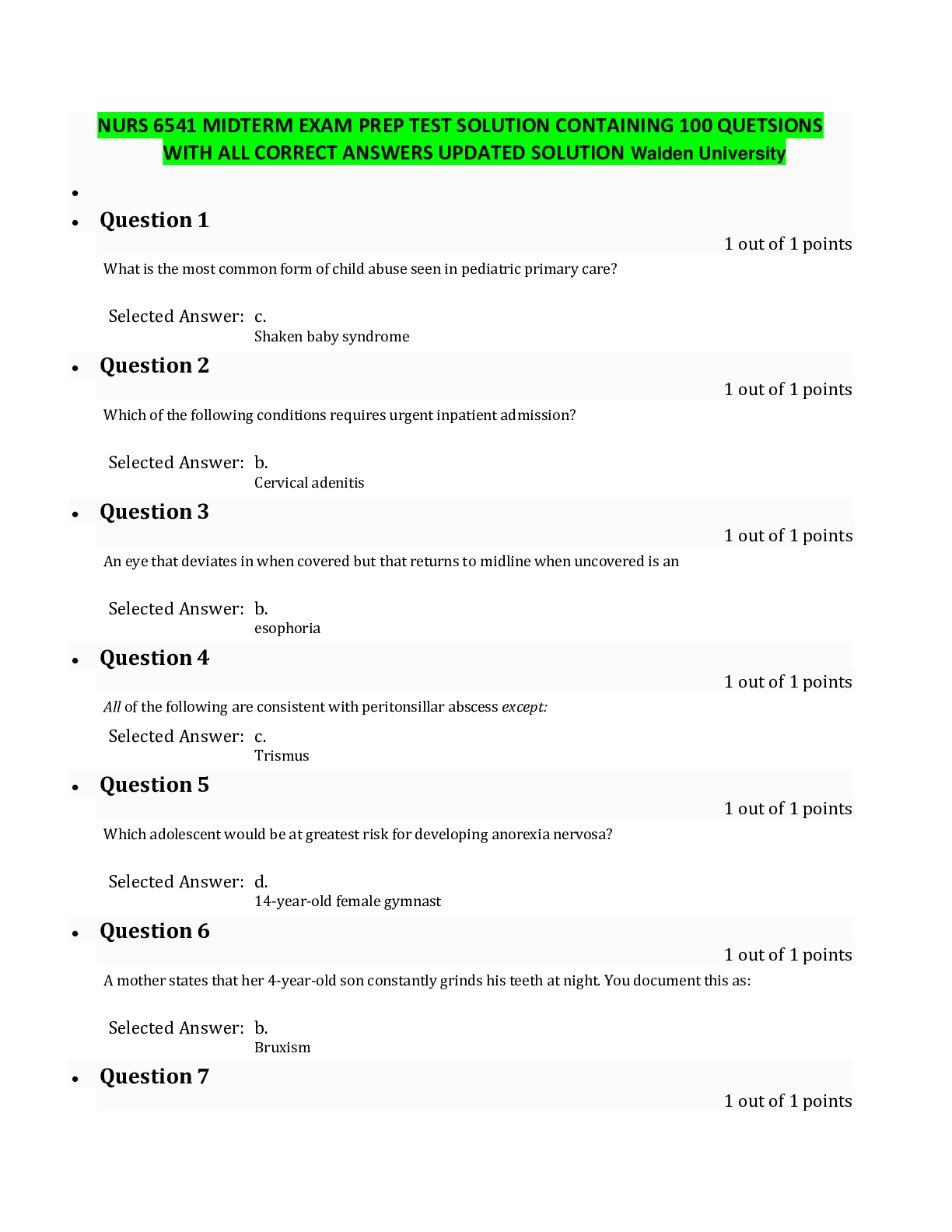
Reviews( 0 )
Document information
Connected school, study & course
About the document
Uploaded On
Sep 05, 2020
Number of pages
17
Written in
Additional information
This document has been written for:
Uploaded
Sep 05, 2020
Downloads
0
Views
130



 WITH COMPLETE SOLUTION.png)
.png)
 COMPLETE SOLUTION.png)
.png)
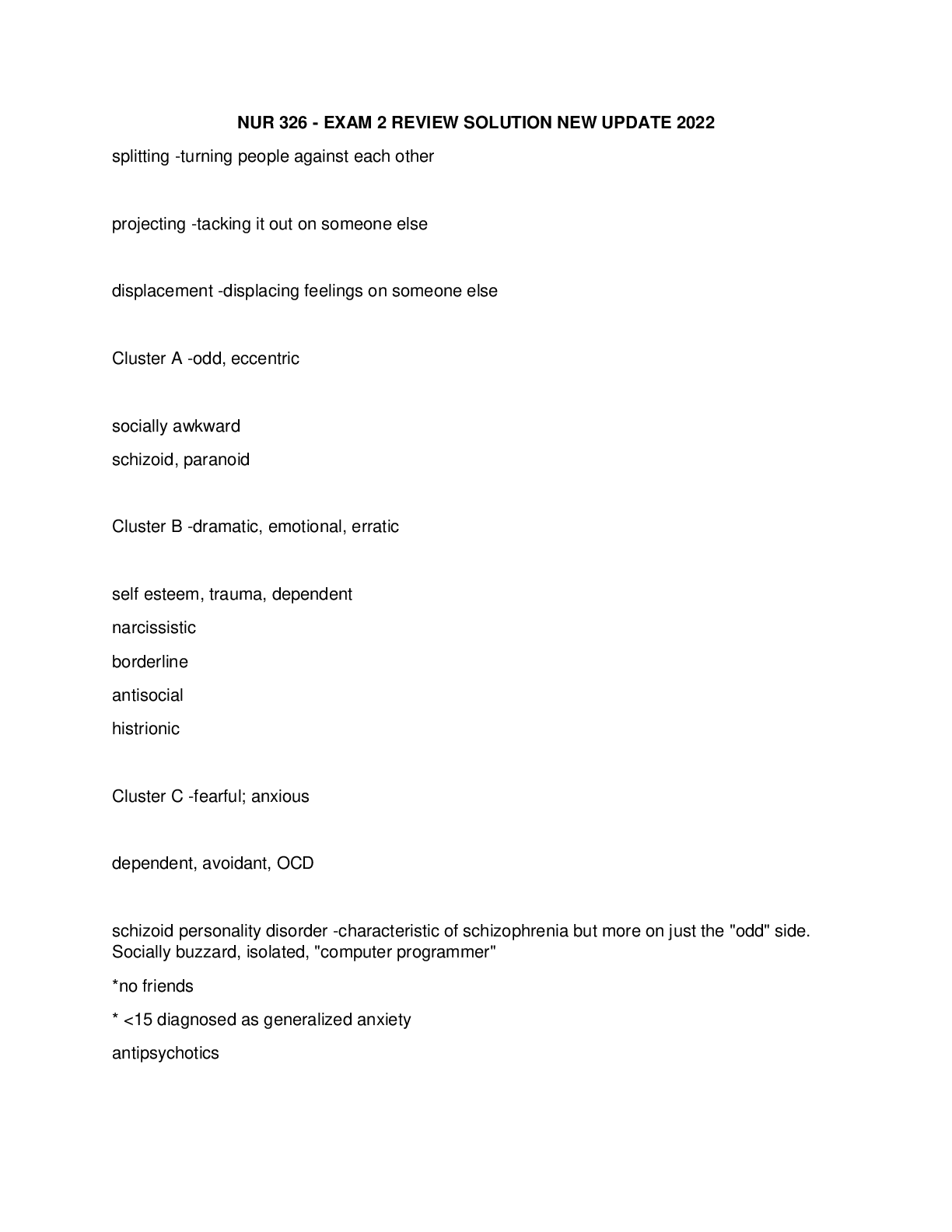
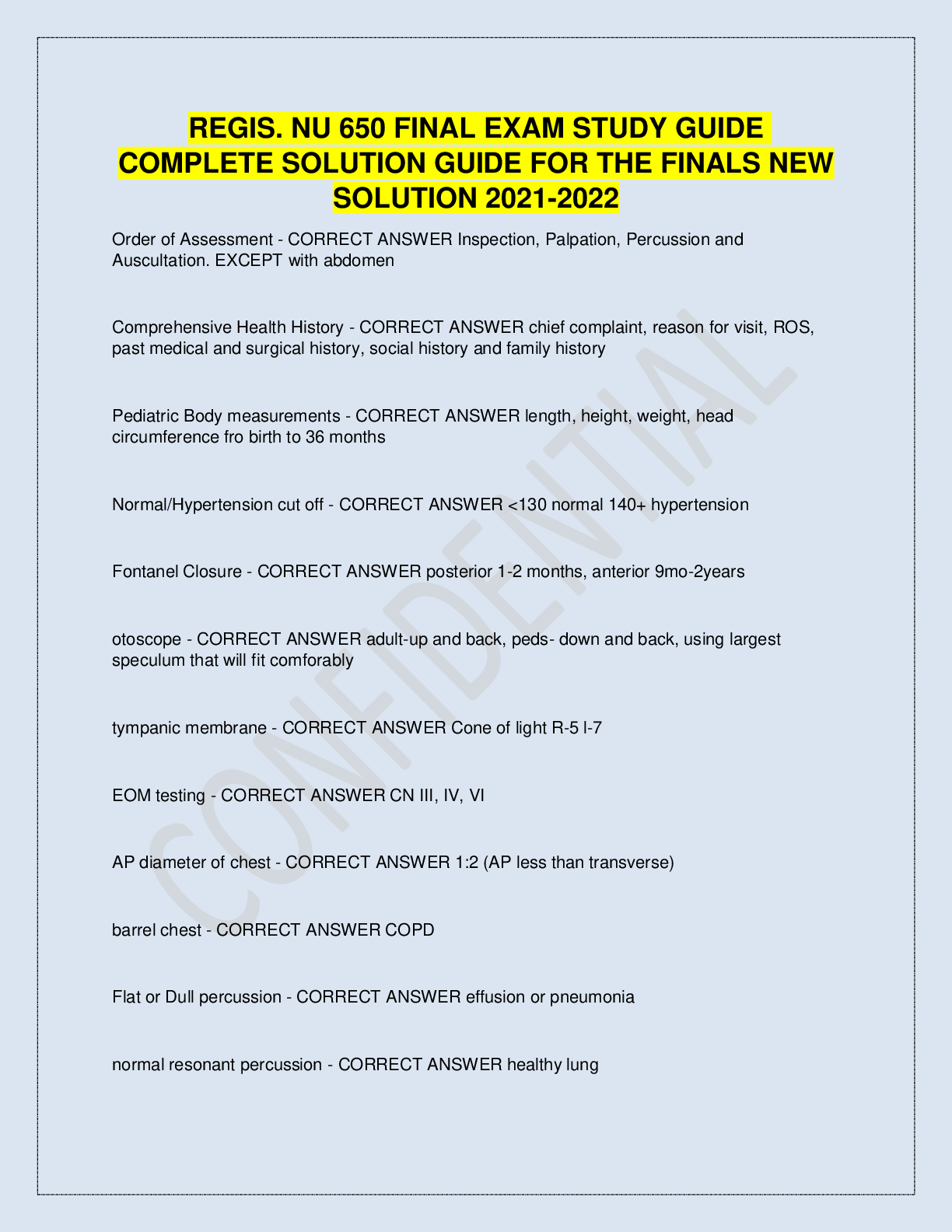
.png)
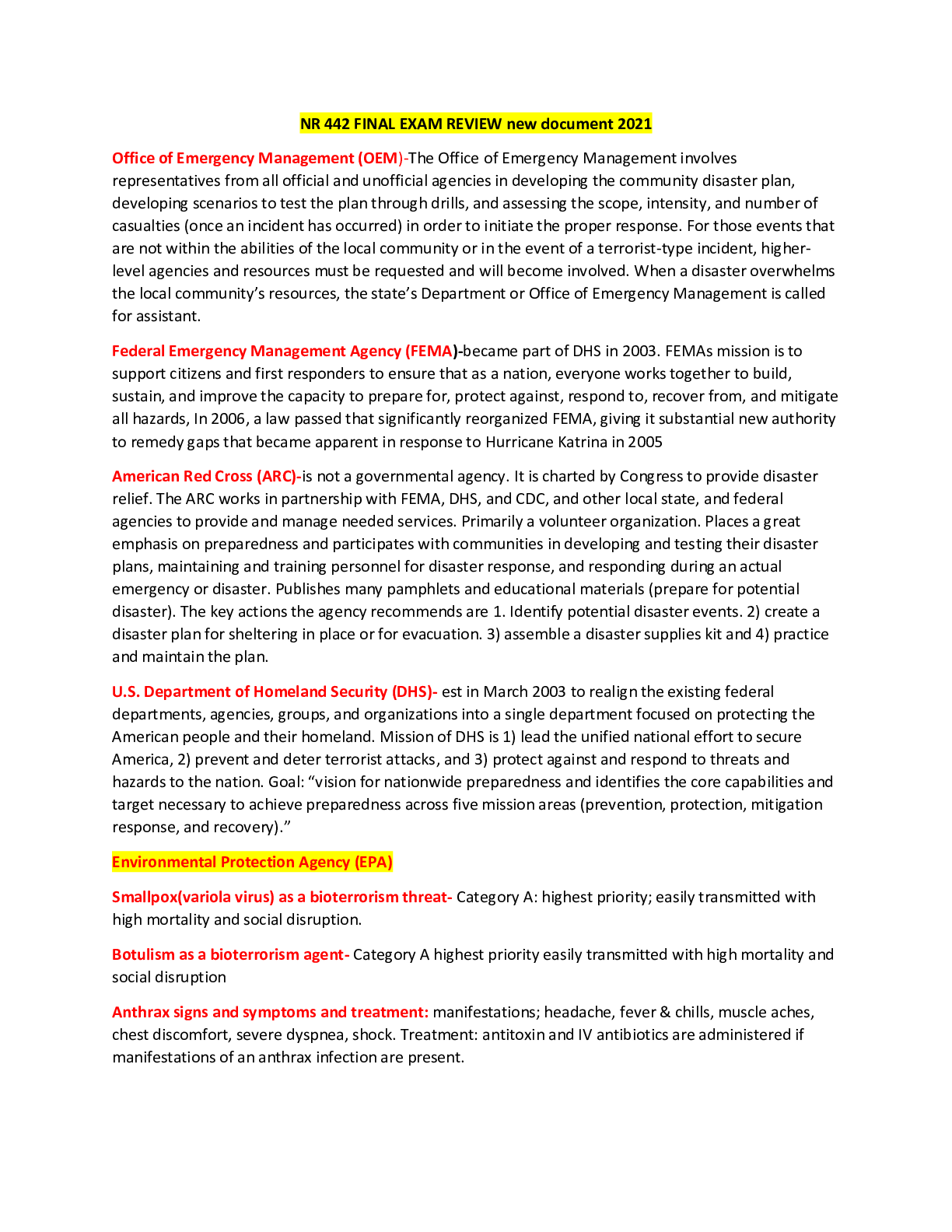

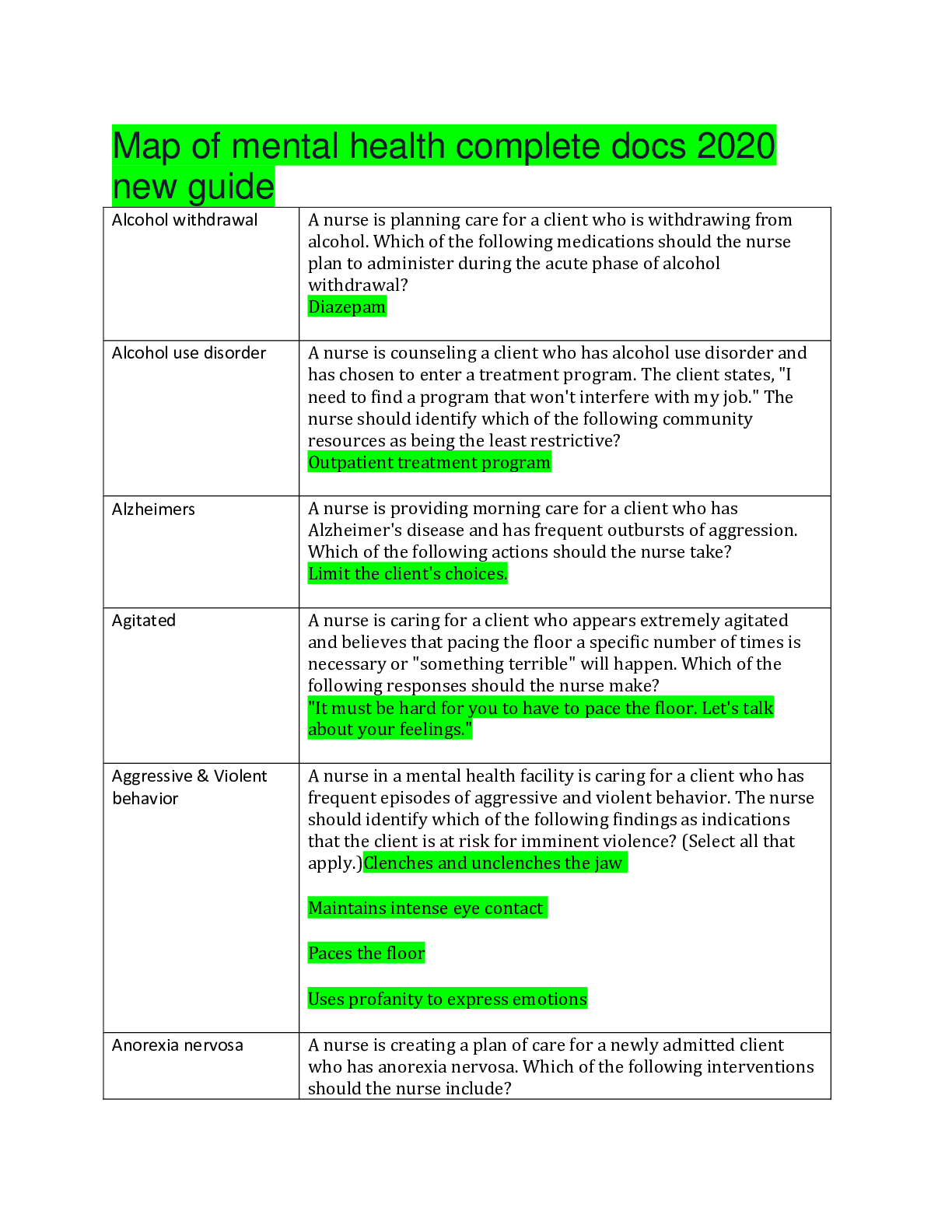
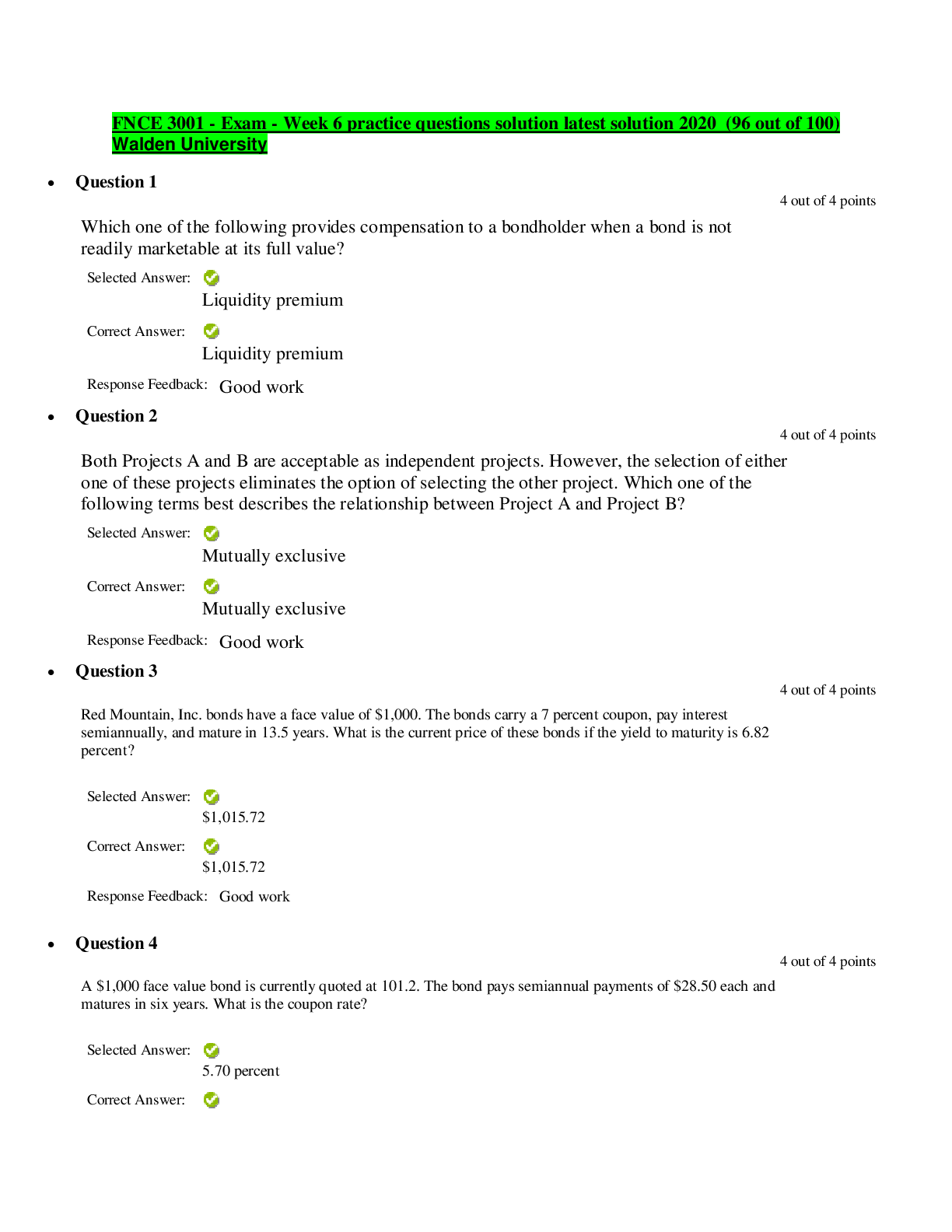



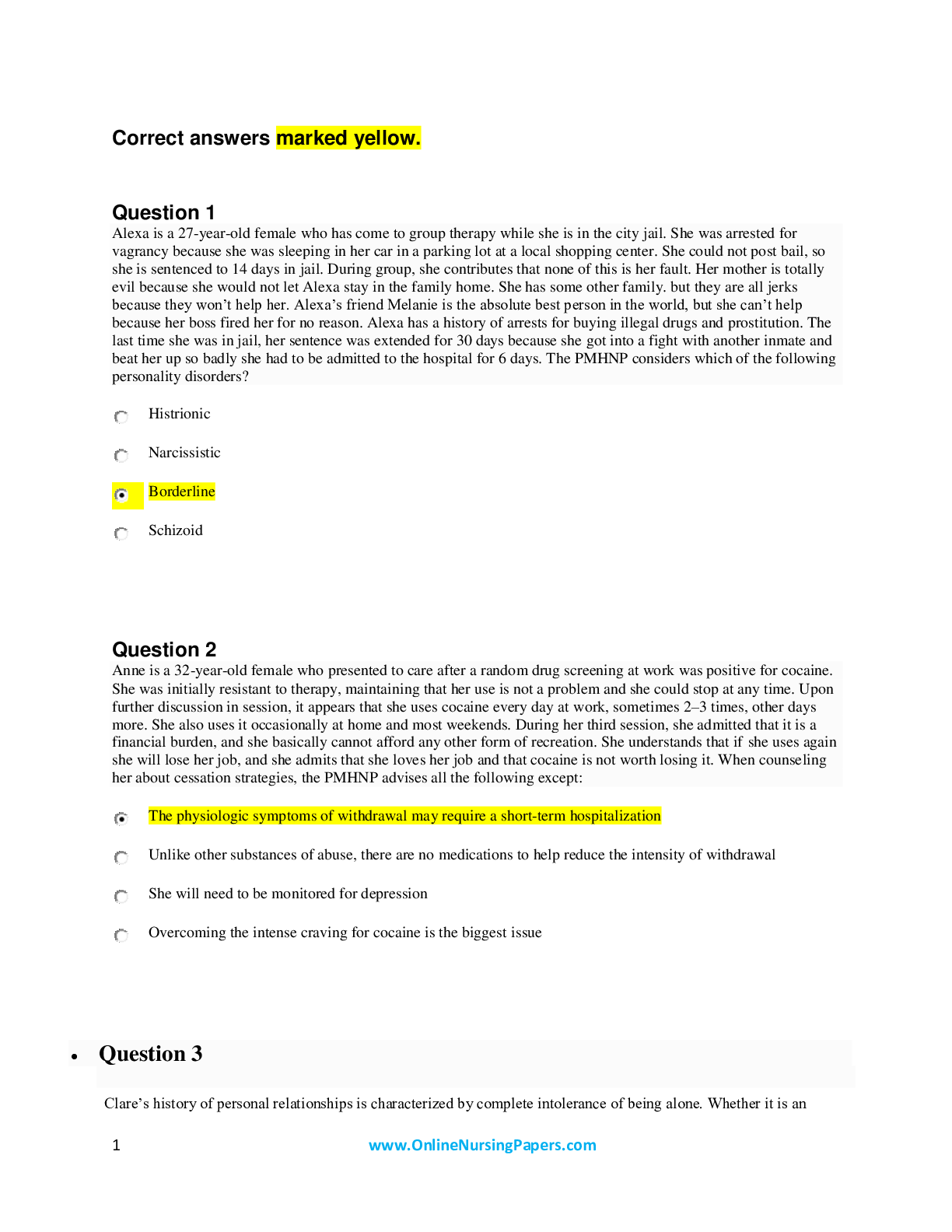
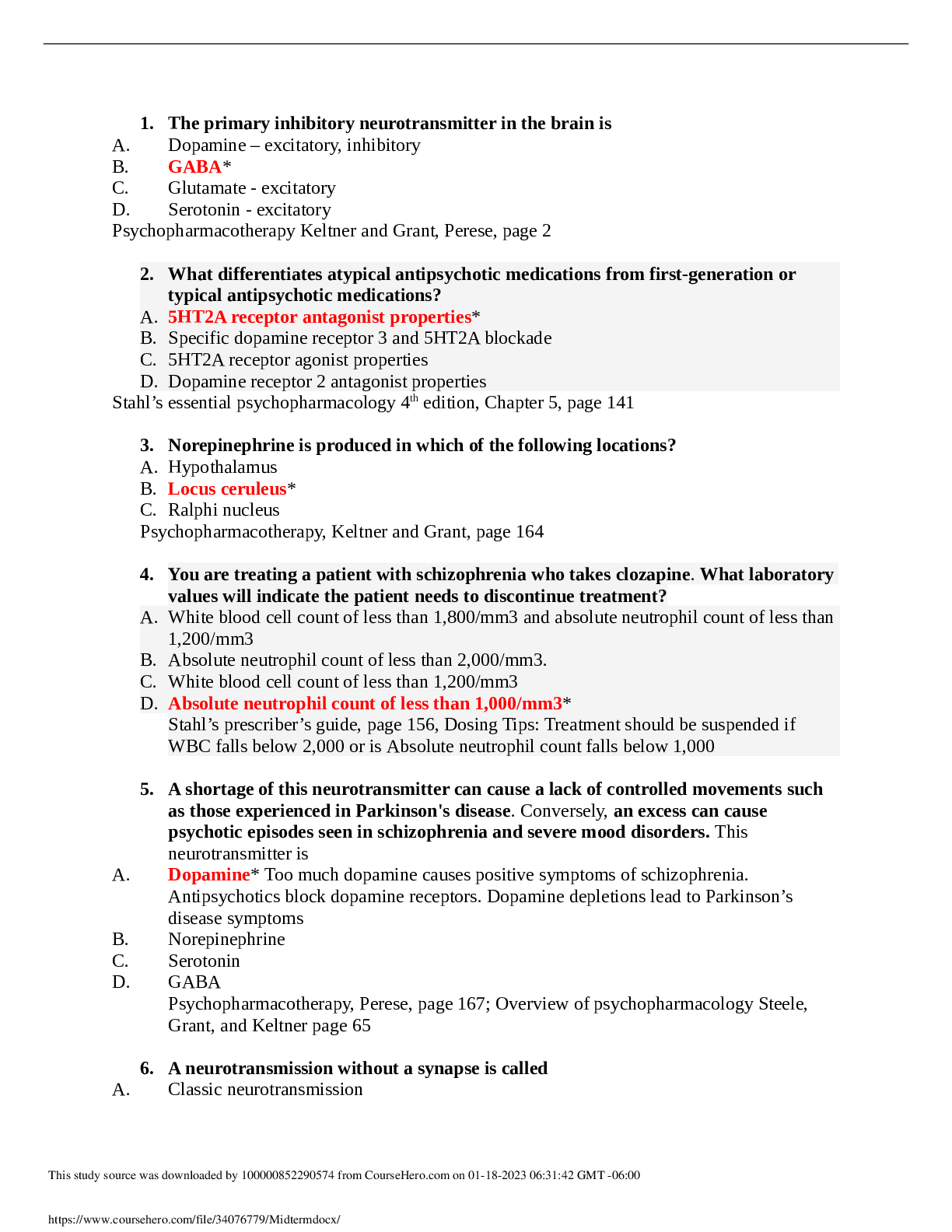
.png)
.png)
